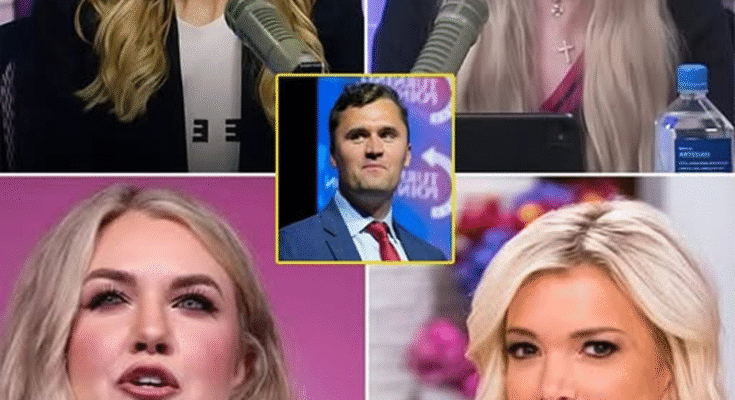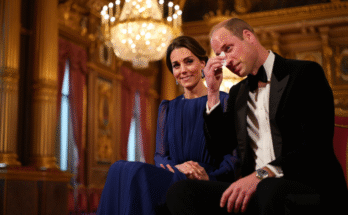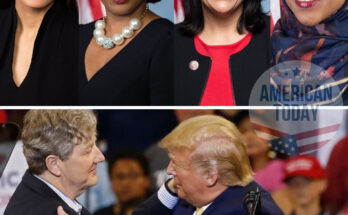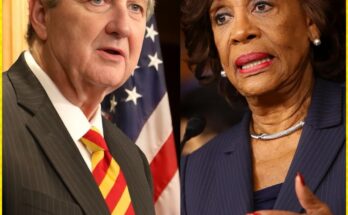“The Broadcast That Broke the Internet — Inside the Unbelievable Global Explosion of ‘The Charlie Kirk Show,’ the 1.5 Billion–View Phenomenon That Has Streaming Giants Panicking, Critics Divided, and Insiders Asking If We’ve Just Witnessed the Birth of a New Media Era.”
1. The Episode That No One Saw Coming
It began quietly — no fireworks, no countdowns, no viral stunts.
Just a sleek black title card that read:
“The Charlie Kirk Show: Episode One — Voices, Vision, and the Future of Conversation.”
Inside a minimalist studio in downtown Nashville, cameras rolled on what was supposed to be a pilot — a long-form discussion between host Charlie Kirk, journalist Megyn Kelly, and author Erika Kirk.
The tone was calm. Introspective. Human.
They weren’t trying to break records. They were trying to start a conversation.
But within 48 hours, that conversation would become the conversation — an online tidal wave that no algorithm, streaming platform, or marketing team could explain.

2. The Spark
The first clue came one hour after the episode premiered on YouTube.
The analytics team noticed something strange — view counts weren’t climbing steadily. They were surging.
Hundreds of thousands of views per second.
Then millions.
Then tens of millions.
No paid ads, no network support — just a clip circulating on social media with the caption:
“This doesn’t feel like an interview. It feels like a moment.”
Within hours, “#TheCharlieKirkShow” trended across 27 countries.
3. The Shock in the Control Room
At 3:17 a.m., the studio’s control room was still buzzing. Engineers stared at dashboards flashing red from traffic overloads.
A producer whispered, “This can’t be real. It’s like the Internet broke itself.”
The analytics confirmed the impossible — simultaneous viewership in 110 countries.
The video had been translated and subtitled into 42 languages by fans, not official distributors.
Something had transcended media.
The episode wasn’t just watched — it was felt.
4. The Conversation That Captured the World
So what did they actually talk about?
It wasn’t politics. It wasn’t scandal.
It was… authenticity.
Megyn Kelly spoke about rediscovering truth in a world drowning in noise.
Erika Kirk shared a story about vulnerability, about the cost of living honestly in a curated culture.
Charlie Kirk listened — really listened — and asked questions that didn’t sound rehearsed.
They spoke about family, faith, creativity, fear, and how technology was reshaping human empathy.
At one point, Megyn said softly,
“Maybe people don’t want to be told what to think anymore. Maybe they just want someone brave enough to ask what we’ve all forgotten to feel.”
That line became the heartbeat of the phenomenon.
Within hours, it had been quoted, remixed, and etched across every digital platform.
5. The Streaming Shockwave
When the official numbers came in, even the streaming giants were blindsided.
Netflix issued a statement calling the episode “a cultural anomaly.”
Spotify executives reportedly convened an emergency meeting.
YouTube’s algorithm team confirmed it was “the fastest organic acceleration in platform history.”
A single 90-minute conversation had outperformed the view counts of blockbuster trailers and global music releases.
It wasn’t entertainment. It was a shift in gravity.
The question was: Why?
6. The Theories Begin
Industry experts scrambled to explain the explosion.
Some called it nostalgia — a hunger for genuine long-form storytelling in an era of 15-second clips.
Others blamed the “attention economy,” arguing that audiences were tired of filters and sound bites.
But a few insiders whispered a different theory — one bordering on the mystical.
“There are moments when culture bends,” said one executive anonymously. “When people stop scrolling and start listening. This was one of those.”
The episode had hit an invisible frequency — one that transcended sides, screens, and algorithms.
7. The Reaction
Across the world, the response was unlike anything the media industry had ever seen.
In Tokyo, thousands gathered in digital cafes to rewatch the episode with subtitles projected on walls.
In São Paulo, students organized discussion groups around quotes from the show.
In Johannesburg, a radio host called it “the most honest broadcast of the decade.”
Even late-night hosts, usually competitors, mentioned it on-air. One said, half-joking,
“When a podcast gets more views than the Super Bowl, maybe we’re all in the wrong business.”
8. The Silence from the Top
While the world reacted, the show’s creators stayed silent.
No press releases. No media tour. No interviews.
Charlie Kirk posted a single message on social media:
“The numbers aren’t what matter. The message is.”
That tweet received 14 million likes in 24 hours.
When reporters reached out to his team for comment, one publicist simply said,
“The show isn’t about fame. It’s about rediscovering conversation.”
But internally, the team was stunned. The platform hosting the video had to expand capacity just to handle the traffic.
9. The Data Nobody Expected
The findings were stranger than fiction.
The audience wasn’t limited to one demographic — it spanned every continent, age group, and language category.
And more importantly, average view duration — the holy grail of digital engagement — was over 84 minutes.
That meant people weren’t skipping or multitasking. They were watching the whole thing.
A media professor from NYU described it perfectly:
“It’s as if people around the world decided, simultaneously, to slow down and listen.”
10. The Second Wave
As the world digested what had happened, something even more mysterious began.
Clips from the show inspired a wave of response videos — ordinary people sharing personal stories, reflections, and reactions.
One montage titled “The Way We Listen Now” compiled voices from 50 countries — a mosaic of accents and faces all repeating the same phrase from the episode:
“We just want to feel something real.”
That video alone hit 400 million views in a week.
It wasn’t just content anymore.
It was becoming a movement.
11. The Industry in Chaos
Streaming executives convened emergency summits on “authenticity-driven engagement.”
Newsrooms began reformatting segments into deeper conversations.
Even rival hosts started adjusting their tone — less performance, more presence.
A senior producer at a major network admitted,
“It scared us. It proved that the audience didn’t need a studio or a budget — they needed sincerity.”
Ad agencies began rewriting their scripts.
Brands wanted to sound “human” again.
And behind closed doors, executives used a new phrase to describe the shift:
“The Nashville Effect.”
12. The Whisper of Something Bigger
Weeks after the debut, a curious email leaked from a streaming executive to his board.
It read:
“If Episode One did this, what happens when they release Episode Two?”
Speculation spread.
Would the next episode continue the same tone, or was this a one-time miracle?
Would the magic hold, or was the world simply caught off guard?
Insiders hinted that the next installment was already in production — filmed secretly, under a codename: Project Resonance.
No details. No leaks. Just a single word.
13. The Cultural Shift
Universities began hosting panels titled “The Era of Real Conversation.”
Sociologists called the viral success “a collective hunger for connection.”
Even politicians and celebrities — usually divided by ideology or branding — quoted lines from the episode in speeches and interviews.
Everywhere, one question lingered:
“What happens when truth goes viral?”
14. The Mystery Behind the Curtain
Weeks later, one of the studio technicians finally spoke publicly.
“What people don’t know,” he said, “is that during filming, the power went out for almost five minutes. The cameras kept running on battery. During that silence, they just… talked. No scripts. No edits. That’s the footage that changed everything.”
In that five-minute unscripted stretch, they hadn’t planned anything.
They’d talked about fear, hope, and how every generation thinks it’s too late to listen — until someone proves it isn’t.
That raw, uncut moment became the centerpiece of the viral clip — the heartbeat of the phenomenon.
15. The Echo
Months later, analysts still couldn’t explain it.
How a show with no marketing budget, no celebrity spectacle, and no controversy became the most-watched broadcast in modern history.
But maybe it didn’t need explanation.
Maybe it was just the right moment — when the world, tired of noise, turned down the volume and finally heard something worth hearing.
As one fan wrote beneath the video:
“It wasn’t the views that shocked me. It was realizing I wasn’t watching — I was remembering.”
Epilogue — The Future Begins Again
Late one night, a new teaser quietly appeared on the show’s channel.
No faces. No title. Just a voice — soft, steady, familiar.
“We’re not done talking yet.”
Then the screen faded to black.
Three words appeared:
“Episode Two — Soon.”
And just like that, the countdown to the next cultural earthquake began.



